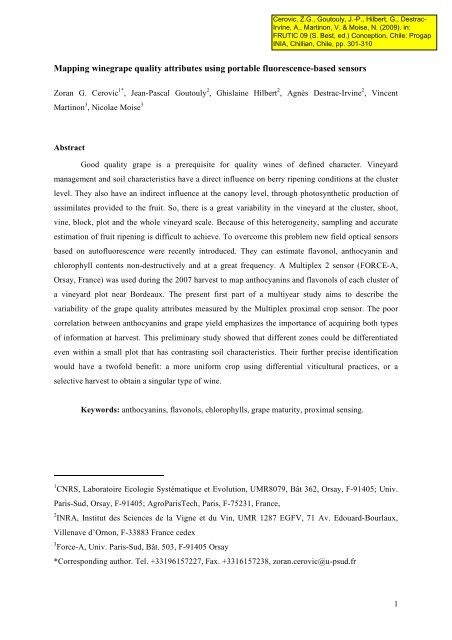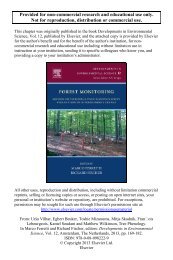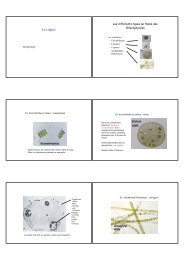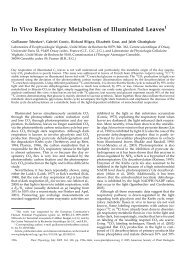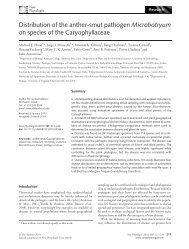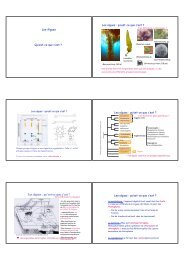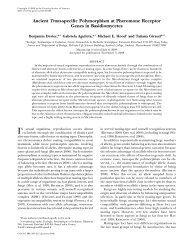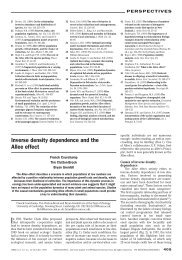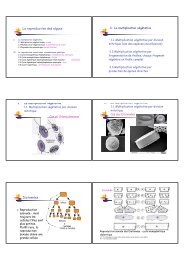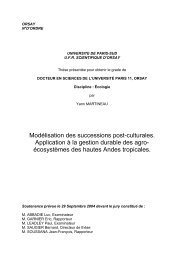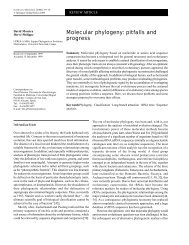Mapping winegrape quality attributes using portable fluorescence ...
Mapping winegrape quality attributes using portable fluorescence ...
Mapping winegrape quality attributes using portable fluorescence ...
Create successful ePaper yourself
Turn your PDF publications into a flip-book with our unique Google optimized e-Paper software.
to constant-distance measurements, like for berries on trays or bunches pressed against the blackscreen (provided with the Multiplex)(cf. Figure 2 A). All three anthocyanin-related indices showed adecreased anthocyanin skin content in clusters harvested in the far south part of the plot, the poorest inclay and with larger amounts of organic matter (Jean-Pierre Soyer, INRA Bordeaux, personalcommunication) (Figure 6). For the rest of the plot, it is important to note that the FERARI index(base on single signal) was quite differently distributed than ANTH and ANTH_GR based onexcitation ratios. Multiplex indices related to Anth showed all a spatial structure but not so close to thepattern shown by the wet chemistry data (Figure 4). The origin of these discrepancies need furtherstudies and repeated comparisons in the following years.The Blue-to-Red emission Ratio (BRR_FRF), of BGF and FRF excited under UV, is anindicator of a very large number of situations: nutrient deficiency in maize, water stress, presence ofpathogens, discrimination of plant species (for a review see Cerovic et al., 1999) and grape maturation(Cerovic et al., 2008). Because of this richness this index should be used only in well-definedconditions. For red grapes, it was shown to bare an information on maturity similar to FERARI, asseen here in Figure 6.The emission ratio, SFR_G and SFR_R, are linked to the chlorophyll content of the sample(cf. Buschmann, 2007). They are Simple chlorophyll Fluorescence Ratios (SFR) of far-red emission(FRF, 735 nm) divided by red emission (FR, 685 nm), with green (G) or red-orange (R) excitation.Due to the overlap of the chlorophyll absorption and emission spectrum, re-absorption occurs atshorter wavelengths (RF) but not at longer wavelengths (FRF) (cf. Buschmann, 2007). Therefore,SFR=FRF/RF increases with the increase of sample chlorophyll content. It should be noted that theinverse ratio, RF/FRF, is often used in the literature. The latter will decrease with the increase inchlorophyll content. The well-structured map (Nugget = 9%) of the SFR_G index showed apronounced West-to-East dichotomy. A larger SFR_G correlated with lower anthocyanin measured bywet chemistry (Figure 4) even better than the Anth Multiplex indices (Figure 6).The NBI_G = FRF_UV/FR_G and NBI_R = FRF_UV/FR_R are complex excitation-emissionratios that will depend both on epidermal phenolics and chlorophyll (cf. above). NBI stands forNitrogen Balance Index. It is based on the work of the Biospectroscopy team in Orsay on wheat(Cartelat et al., 2005) and several ligneous species (Demotes-Mainard et al., 2008; Meyer et al.,2006). NBI has been shown to respond to nitrogen nutrition of the plant and can be used directly incomparison studies, provided the light and the developmental stage are kept constant among samples.Here the NBI_G measured on grapes seems to be mainly influenced by chlorophyll content (compareto SFR_G in Figure 6).When taking all the data into account, the experimental plot shows two types of spatialstructure. The Western-Eastern difference along the Y-axis is well apparent in the ANTH, FLAV andSFR_G maps (Figure 6). This difference in anthocyanins, flavonols and chlorophylls can be related tothe map of apparent soil resistivity that is lower in the eastern parts of the plot (Figure 4) (cf. also7
Goutouly et al., 2006b). This indication of higher levels of readily available water in clayey easternparts of the plot (cf. Figure 1) is associated to a larger leaf LAI (larger vigour) (Figure 4), thus largershading of clusters, but also larger grape yield (not shown). In that region there would be therefore lessflavonols in grape skins (consequence of shading) but a lager skin anthocyanin content (cf. Figure 6)and lower chlorophyll content attesting for more mature grapes. This is usually the case for Merlotgrown on clayey soils (C. Van Leeuwen, personal communication), as confirmed here.Implementation of Multiplex for viticulture.Assessment of berry mass (size), the most widespread test used for grape <strong>quality</strong> distributionin vineyards showed an important sampling problem. The maps of the derived from 30 berry samplesand 100 berry samples were very different and none showed spatial correlation (Table 3). It isinteresting to note that the maps of the two major <strong>quality</strong> <strong>attributes</strong> for red-wine grapes, anthocyaninsand sugar content, have quite different patterns indicating a multi-parametric control that needs furtheranalysis. Fluorescence sensing and mapping shown here can advantageously be used to define zonesof high and low grape <strong>quality</strong> (Bramley and Janik, 2005), to verify the technical opportunity indexes(Tisseyre and McBratney, 2008) or to be included in the definition of management zones (Bramleyand Janik, 2005; Taylor et al., 2005). But more importantly, it has generated sets of data that, providedadequate statistical treatment and incorporation in a physiological model, would yield understandingon the relationship between remotely sensed vegetative indices and soil-based estimation of readilyavailable water and grape <strong>quality</strong> <strong>attributes</strong>.ConclusionsWe showed that a spatial structure of grape <strong>attributes</strong> exists at the chosen experimental plotand that it can be assessed (mapped) by the Multiplex optical proximal crop sensor. We will pursuethe acquisition of optical sensed <strong>quality</strong> <strong>attributes</strong> on the same plot in the next years. This will permitus to analyse the physical basis of <strong>quality</strong> <strong>attributes</strong> spatial variability and hopefully to understand theunderlying controlling physiological processes. Multi-annual data will allow us not only to verify theconstancy and robustness of the spatial patterns but also to perform in-depth statistical analysis, likeco-krigging of optical and wet chemistry data.AcknowledgementsThe authors would like to thank Kamel Soudani for advices on geostatistical analysis.8
Literature CitedAdams, D.O., 2006. Phenolics and ripening in grape berries. Am. J. Enol. Vitic. 57, 249-256.Agati, G., Meyer, S., Matteini, P., Cerovic, Z.G., 2007. Assessment of anthocyanins in grape (Vitisvinifera L.) berries <strong>using</strong> a non-invasive chlorophyll <strong>fluorescence</strong> method. J. Agric. Food Chem. 55,1053-1061.Agati, G., Pinelli, P., Cortés Ebner, S., Romani, A., Cartela, A., Cerovic, Z.G., 2005. Non-destructiveevaluation of anthocyanins in olive (Olea europaea) fruits by in situ chlorophyll <strong>fluorescence</strong>spectroscopy. J. Agric. Food Chem. 53, 1354-1363.Agati, G., Traversi, M.L., Cerovic, Z.G., 2008. Chlorophyll <strong>fluorescence</strong> imaging for the non-invasiveassessment of anthocyanins in whole grape (Vitis vinifera L.) bunches. Photochem. Photobiol., inpress, DOI 10.1111/j.1751-1097.2008.00424.x.Ben Ghozlen, N., Moise, N., Latouche, G., Martinon, V., Mercier, L., Besançon, E., Cerovic, Z.G.,2008. Assessment of grapevine maturity <strong>using</strong> new <strong>portable</strong> sensor: Non-destructive quantification ofanthocyanins. J. Int. Sci. Vigne Vin, submitted.Bilger, W., Johnsen, T., Schreiber, U., 2001. UV-excited chlorophyll <strong>fluorescence</strong> as a tool for theassessment of UV-protection by the epidermis of plants. J. Exp. Bot. 52, 2007-2017.Bilger, W., Veit, M., Schreiber, L., Schreiber, U., 1997. Measurement of leaf epidermal transmittanceof UV radiation by chlorophyll <strong>fluorescence</strong>. Physiol. Plant. 101, 754-763.Bramley, R., 2005. Understanding variability in <strong>winegrape</strong> production systems. 2. Within vineyardvariation in <strong>quality</strong> over several vintages. Aust. J. Grape Wine Res. 11, 33-42.Bramley, R., Hamilton, R., 2004. Understanding variability in <strong>winegrape</strong> production systems. 1.Within vineyard variation in yield over several vintages. Aust. J. Grape Wine Res. 10, 32-45.Bramley, R.G.V., Janik, L.J., 2005. Precision agriculture demands a new approach to soil and plantsampling and analysis—examples from Australia. Commun. Soil Sci.Plant Anal. 36, 9-22.Buschmann, C., 2007. Variability and application of the chlorophyll <strong>fluorescence</strong> emission ratiored/far-red of leaves. Photosynth. Res. 92, 261–271.Cambardella, C.A., Moorman, T.B., Parkin, T.B., Karlen, D.L., Novak, J.M., Turco, R.F., Konopka,A.E., 1994. Field-scale variability of soil properties in central Iowa soils. Soil Sci. Soc. Am. J. 58,1501-1511.Cartelat, A., Cerovic, Z.G., Goulas, Y., Meyer, S., Lelarge, C., Prioul, J.-L., Barbottin, A., Jeuffroy,M.-H., Gate, P., Agati, G., Moya, I., 2005. Optically assessed contents of leaf polyphenolics andchlorophyll as indicators of nitrogen deficiency in wheat (Triticum aestivum L.). Field Crops Res. 91,35-49.Cayla, L., Cottereau, P., Renard, R., 2002. Estimation de la maturité phénolique des raisins rouges parla méthode I.T.V. standard. Revue Française d'Oenologie 193, 10-16.9
Cerovic, Z.G., Moise, N., Agati, G., Latouche, G., Ben Ghozlen, N., Meyer, S., 2008. New <strong>portable</strong>optical sensors for the assessment of <strong>winegrape</strong> phenolic maturity based on berry <strong>fluorescence</strong>. J.Food Comp. Anal. 21, 650-654.Cerovic, Z.G., Moise, N., Agati, G., Latouche, G., Ghozlen, N.B., Meyer, S., 2007. New <strong>portable</strong>optical sensors for the assessment of <strong>winegrape</strong> phenolic maturity based on berry <strong>fluorescence</strong>. In:Stafford, J.V. (Ed.) Precision Agriculture '07 Wageningen Academic Publishers, Wageningen, pp.poster 035, p. 1-6.Cerovic, Z.G., Ounis, A., Cartelat, A., Latouche, G., Goulas, Y., Meyer, S., Moya, I., 2002. The use ofchlorophyll <strong>fluorescence</strong> excitation spectra for the nondestructive in situ assessment of UV–absorbingcompounds in leaves. Plant Cell Environ. 25, 1663-1676.Cerovic, Z.G., Samson, G., Morales, F., Tremblay, N., Moya, I., 1999. Ultraviolet-induced<strong>fluorescence</strong> for plant monitoring: present state and prospects. Agronomie: Agriculture andEnvironment 19, 543-578.Conde, C., Silva, P., Fontes, N., Dias, A.C.P., Tavares, R., Sousa, M.J., Agasse, A., Delrot, S., Geros,H., 2007. Biochemical changes throughout grape berry development and fruit and wine <strong>quality</strong>. Food1, 1-22.Demotes-Mainard, S., Boumaza, R., Meyer, S., Cerovic, Z.G., 2008. Indicators of nitrogen status forornamental woody plants based on optical measurements of leaf polyphenolics and chlorophyllcontents. Sci. Hort. 115, 377-385.Gaudillère, J.-P., Van Leeuwen, C., Ollat, N., 2002. Carbon isotope composition of sugars ingrapevine, an integrated indicator of vineyard water status. J. Exp. Bot. 53, 757-763.Goutouly, J.-P., Rousset, D., Perroud, H., Gaudillère, J.-P., 2006a. Characterization of spatial andtemporal soil water status in vineyard by DC resistivity measurements. Actes du VI e CongrèsInternational des Terroirs Viticoles ENITA, Bordeaux-Montpellier, pp. 292-297.Goutouly, J.P., Drissi, R., Forget, D., Gaudillère, J.P., 2006b. Caractérisation de la vigueur de la vignepar indice NDVI mesuré au sol. Actes du VI e Congrès International des Terroirs Viticoles ENITA,Bordeaux-Montpellier, pp. 237-242.Hagen, S.F., Solhaug, K.A., Bengtsson, G.B., Borge, G.I.A., Bilger, W., 2006. Chlorophyll<strong>fluorescence</strong> as a tool for non-destructive estimation of anthocyanins and total flavonoids in apples.Postharv. Biol. Technol. 41, 156-163.Kolb, C.A., Wirth, E., Kaiser, W.M., Meister, A., Riederer, M., Pfündel, E.E., 2006. Noninvasiveevaluation of the degree of ripeness in grape berries (Vitis vinifera l. cv. Bacchus and Silvaner) bychlorophyll <strong>fluorescence</strong>. J. Agric. Food Chem. 54, 299-305.Merzlyak, M.N., Melø, T.B., Naqvi, K.R., 2008. Effect of anthocyanins, carotenoids, and flavonols onchlorophyll <strong>fluorescence</strong> excitation spectra in apple fruit: signature analysis, assessment, modelling,and relevance to photoprotection. J. Exp. Bot. 59, 349-359.10
Meyer, S., Cerovic, Z.G., Goulas, Y., Montpied, P., Desmotes-Mainard, S., Bidel, L., Moya, I.,Dreyer, E., 2006. Relationships between optically assessed polyphenols and chlorophyll content andthe dry mass per leaf area ratio of woody plants: a signature of the carbon and nitrogen balance withinleaf? Plant Cell Environ 29, 1338–1348.Ounis, A., Cerovic, Z.G., Briantais, J.-M., Moya, I., 2001. Dual excitation FLIDAR for the estimationof epidermal UV absorption in leaves and canopies. Remote Sens. Environ. 76, 33-48.Pfündel, E.E., Ben Ghozlen, N., Meyer, S., Cerovic, Z.G., 2007. Investigating UV screening in leavesby two different types of <strong>portable</strong> UV fluorimeters reveals in vivo screening by anthocyanins andcarotenoids. Photosynth. Res. 93, 205-221.Spayd, S.E., Tarara, J.M., Mee, D.L., Ferguson, J.C., 2002. Separation of sunlight and temperatureeffects on the composition of Vitis vinifera cv. Merlot berries. Am. J. Enol. Vitic. 53, 171-182.Taylor, J., Tisseyre, B., Praat, J.-P., 2005. Bottling good information: mixing tradition and technologyin vineyards. FRUTIC 05, Montpellier France, pp. 719-735.Tisseyre, B., McBratney, A.B., 2008. A technical opportunity index based on mathematicalmorphology for site-specific management: an application to viticulture Precision Agric. 9, 101-113.Table 1. Nomenclature of the Multiplex signals. The <strong>fluorescence</strong> excitation-emission matrix:emission abbreviation_excitation abbreviation. “=R” stands for reflectance.Excitation (nm)Emission (nm) UV (375) Blue (B) (470) Green (G) (516) Red-Orange (R) (625)YF (590) YF_UV YF_B = R YF_G = R YF_R = RRF (685) RF_UV RF_B RF_G RF_RFRF (735) FRF_UV FRF_B FRF_G FRF_RTable 2. Nomenclature of the Multiplex signal ratios (indices). A sub-sample of the 66 possiblecombinations is presented that is calculated online by the sensor on each individual flash combination.YF_UV RF_G FRF_G RF_R FRF_RFRF_UV BRR_FRF NBI_G - NBI_R FER_RUVFLAVRF_G - - SFR_G - -FRF_G - - - - FER_RGANTHRF_R - - - - SFR_R11
Table 3. Summary statistics for selected Multiplex signals and indices and other plot <strong>attributes</strong>. Modelparameters fitted to experimental variograms used for krigging of maps presented in Figures 4 to 6.Model Descriptive statistics Variogram parameters RangeMean 1 Range 2 CV SpreadNugget(%) (%) 3 Still Scale Nugget(%)(m)YF_UV Exp 51 24 12 47 57 57 0 0 38RF_UV Exp 33 39 26 118 110 100 10 9 20FRF_UV Exp 36 42 25 121 100 100 0 0 13YF_B Exp 212 34 3 16 54 54 0 0 5RF_B Exp 123 127 21 104 880 680 200 23 13FRF_B Exp 127 131 21 108 880 680 200 23 13YF_G Exp 3825 602 3 16 26500 21500 5000 19 16RF_G Exp 9 11 28 122 8 7 1 13 12FRF_G Exp 15 16 23 106 14 12 2 14 10RF_R Exp 118 143 23 124 760 760 0 0 7FRF_R Exp 168 230 26 144 1840 1840 0 0 7SFR_G Exp 2.07 1.35 17 68 0.175 0.16 0.015 9 12SFR_R Exp 1.43 0.41 5 29 0.0039 0.0016 0.0023 59 4BRR Exp 1.64 1.4 16 87 0.066 0.047 0.019 29 7FER_RUV Exp 4.91 2.91 13 61 0.44 0.44 0 0 5FLAV Exp 0.67 0.24 8 37 0.0032 0.0026 0.0006 19 8FER_RG Exp 12.66 8.83 13 72 2.85 2.85 0 0 6ANTH Exp 0.49 0.24 10 51 0.0025 0.0023 0.0002 8 7NBI_G Exp 5.6 5.72 21 106 1.75 1.15 0.6 34 8FERARI Sph 1.52 0.5 7 33 0.0115 0.009 0.0025 22 24Clusters/vine Sph 6.29 6 17 95 0.98 0.48 0.5 51 10Cluster mass (g) no 191 164 15 85 - - - - -Yield (kg/vine) no 1.2 1.41 20 115 - - - - -Berry mass (g) no 1.8 0.44 5 24 - - - - -Anth (g/L) Exp 1.59 0.69 8 43 0.017 0.0135 0.0035 21 6Total phenolics Sph 7.22 3.312 8 45 0.36 0.25 0.11 31 12 13 C Exp -25.41 2.31 2 9 0.365 0.365 0 0 9Sugar (g/L) Sph 242 78 5 32 137 40 97 71 26NDVI Sph 0.67 0.48 13 70 0.0076 0.0014 0.0061 80 181 All signals are in mV.2 Range is derfined as maximum - minimum value.3 Spread is defined as the range devided by the median, expresssed as a percentage (Bramley, 2005).Exp = Exponential, Sph = Spherical, no = no spatial structure.12
Figure 1. Plot characteristics and position of sampled vines (left). Circles indicate theposition of sampled vines and the crosses the center of each of the 96 sampling blocks.Apparent electrical resistivity of the soil (measured in 2003) is overlaid on the relativeelevation wireframe map (right, top). Clay proportion at the depth of 0.5 and 1 m isshown bellow.A) B) C)Figure 2. The Multiplex sensor. A) Measurement in the field. B) Top view of the sensorshowing the touch-screen interface and triggering button. C) Front view of the optical headwith LED sources (6 UV & 3 RGB) and three detectors in the middle (YF, FRF, RF). Fornomenclature see Table 1.Figure 3. Example of variograms for the grape yield, a <strong>fluorescence</strong> signal (FRF_R), and a<strong>fluorescence</strong>-ratio Multiplex index (ANTH).13
Figure 4. Spatial variation in fruit <strong>quality</strong> <strong>attributes</strong> and some commoninformation on the variability of the experimental plot. The name of theindex is indicated under the scale corresponding to the map on its left. Sandproportion in the soil (in %) is given for the 0.5-m and 1-m depths. Notethat the scales are 5 levels of 20 th percentiles. Anth surf.: surface-basedanthocyanin content in nmol/cm 2 . Soil res.: soil apparent resistivity.14
Figure 5. Maps of the twelve <strong>fluorescence</strong> signals (the excitation-emissionmatrix). The 5 levels of the scale reflect a classification of the signal (inmV) based on 20 th percentiles. Maps are oriented with the North on thetop. The signal of yellow reflectance under red-orange excitation wassaturated on half of the plot and therefore not usable.15
Figure 6. Spatial variation of Multiplex indices of fruit <strong>attributes</strong>. Thename of the index is indicated under the scale corresponding to themap on its left. Note that the 5 levels in the scale reflect aclassification of the data based on 20 th percentiles. For nomenclaturesee Table 2 and text.16


